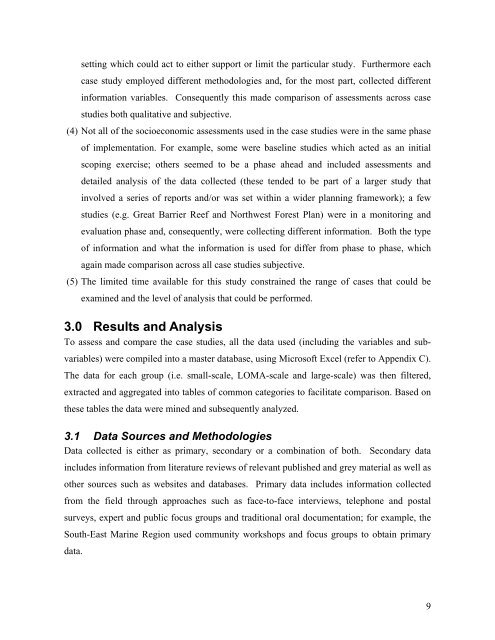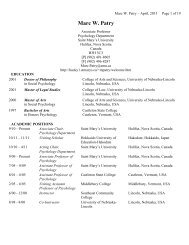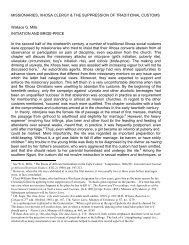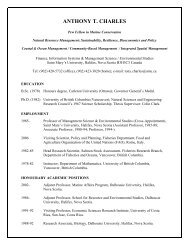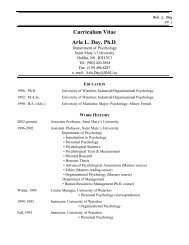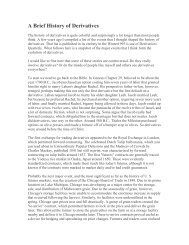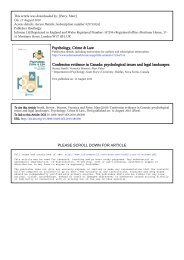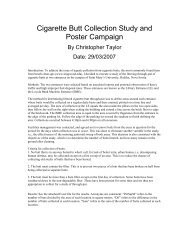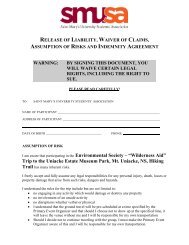Social, Economic and Cultural Overview and Assessment for Ocean ...
Social, Economic and Cultural Overview and Assessment for Ocean ...
Social, Economic and Cultural Overview and Assessment for Ocean ...
You also want an ePaper? Increase the reach of your titles
YUMPU automatically turns print PDFs into web optimized ePapers that Google loves.
setting which could act to either support or limit the particular study. Furthermore each<br />
case study employed different methodologies <strong>and</strong>, <strong>for</strong> the most part, collected different<br />
in<strong>for</strong>mation variables. Consequently this made comparison of assessments across case<br />
studies both qualitative <strong>and</strong> subjective.<br />
(4) Not all of the socioeconomic assessments used in the case studies were in the same phase<br />
of implementation. For example, some were baseline studies which acted as an initial<br />
scoping exercise; others seemed to be a phase ahead <strong>and</strong> included assessments <strong>and</strong><br />
detailed analysis of the data collected (these tended to be part of a larger study that<br />
involved a series of reports <strong>and</strong>/or was set within a wider planning framework); a few<br />
studies (e.g. Great Barrier Reef <strong>and</strong> Northwest Forest Plan) were in a monitoring <strong>and</strong><br />
evaluation phase <strong>and</strong>, consequently, were collecting different in<strong>for</strong>mation. Both the type<br />
of in<strong>for</strong>mation <strong>and</strong> what the in<strong>for</strong>mation is used <strong>for</strong> differ from phase to phase, which<br />
again made comparison across all case studies subjective.<br />
(5) The limited time available <strong>for</strong> this study constrained the range of cases that could be<br />
examined <strong>and</strong> the level of analysis that could be per<strong>for</strong>med.<br />
3.0 Results <strong>and</strong> Analysis<br />
To assess <strong>and</strong> compare the case studies, all the data used (including the variables <strong>and</strong> subvariables)<br />
were compiled into a master database, using Microsoft Excel (refer to Appendix C).<br />
The data <strong>for</strong> each group (i.e. small-scale, LOMA-scale <strong>and</strong> large-scale) was then filtered,<br />
extracted <strong>and</strong> aggregated into tables of common categories to facilitate comparison. Based on<br />
these tables the data were mined <strong>and</strong> subsequently analyzed.<br />
3.1 Data Sources <strong>and</strong> Methodologies<br />
Data collected is either as primary, secondary or a combination of both. Secondary data<br />
includes in<strong>for</strong>mation from literature reviews of relevant published <strong>and</strong> grey material as well as<br />
other sources such as websites <strong>and</strong> databases. Primary data includes in<strong>for</strong>mation collected<br />
from the field through approaches such as face-to-face interviews, telephone <strong>and</strong> postal<br />
surveys, expert <strong>and</strong> public focus groups <strong>and</strong> traditional oral documentation; <strong>for</strong> example, the<br />
South-East Marine Region used community workshops <strong>and</strong> focus groups to obtain primary<br />
data.<br />
9


